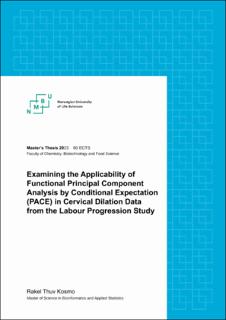| dc.description.abstract | Functional Data Analysis (FDA) is a method for extracting information from curves or functions based on time-related processes with discrete measures. This thesis explores the methodology for constructing and analysing curves studying labour progression, specifically in data containing the cervical dilation of 7277 primiparas. Identifying the trajectory functions of cervical dilation can support the development of tools used by health personnel to identify and monitor deviations from the normal range of cervical dilation and labour duration. Successful application of FDA can also enhance the understanding of potential
explanatory variables that influence the rate and temporal pattern of cervical dilation and its variation among individuals.
Data from digital vaginal exams that measure cervical dilation are complex due to sparse and irregular measurements for each participant and various forms of censoring, such as right censoring due to intrapartum cesarean section. The approach of Principal Analysis by Conditional Expectation (PACE) is explored to address these challenges. PACE is a Functional Principal Component Analysis (FPCA) algorithm that fits curves to sparse and irregular data. The trajectory functions for each participant are attempted to be recovered with corresponding estimates for the derivatives. However, PACE was unsuccessful in fitting curves to the cervical dilation data. Simulated data with known underlying distributions points to the limitations of PACE: When the data consist of multiple distributions and are sufficiently sparse, the method will produce an inaccurate estimation of mean and covariance functions. This means that PACE does not distinguish between different distributed groups; instead, it prioritises and directs the curve trajectories towards the weighted cross-sectional mean.
The implications of PACE being inappropriate for fitting cervical dilation curves include failure to capture data variability and dynamics and the inability to perform functional regression and correlation analysis. The thesis concludes that FDA, in this case, is premature and calls for further development of methods that can handle the level of sparseness,
irregularity, and censoring as seen in data from digital vaginal exams. | |
